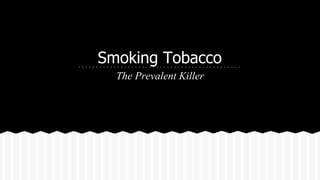Smoking Tobacco Cessation
- 1. Smoking Tobacco The Prevalent Killer
- 2. What We Know About Tobacco Addiction and Long Term Morbidity
- 3. ŌŚÅ Approximately 18.1% of adult Americans are active smokers. ŌŚÅ This is equivalent to nearly 42.1 million American people Statistics *Centers for Disease Control and Prevention 2012
- 4. ŌŚÅ One out of every 5 deaths in America is due to cigarette smoking. ŌŚÅ That means that around 490,000 yearly deaths are 100% preventable. Statistics *Centers for Disease Control and Prevention 2013
- 5. ŌŚÅ Another 16 million Americans will suffer from diseases caused directly from cigarette smoking. Statistics *Centers for Disease Control and Prevention 2013
- 6. ŌŚÅ Despite widespread smoking cessation and prevention initiatives, only 7%, of active smokers who attempt to quit, will be successful this year. Statistics *Statistic Brain 2013
- 7. Primary Problems How Smoking Incites Addiction and Affects Your Brain
- 8. ŌŚÅ While all forms of nicotine addiction are harmful; use specifically via the act of smoking poses the most acute health threats. Nicotine Delivery via Smoking *American Cancer Society 2013
- 9. ŌŚÅ Over 7,000 chemicals are ingested through tobacco smoking, in addition to the nicotine itself. ŌŚÅ Delivery via smoking immediately impacts both brain, circulatory, and lung health. Tobacco Smoke * American Cancer Society 2013
- 10. ŌŚÅ Nicotine use can cause severe physiological and psychological dependence. ŌŚÅ Empirical studies have hypothesized that nicotine addiction may be harder to quit than opiate addiction. Addictive Nature of Tobacco * American Cancer Society 2013
- 11. ŌŚÅ Like any addictive substance, nicotine floods the brain circuitry of users with dopamine. ŌŚÅ Smoking delivers nicotine to the brain within seconds. Addiction as a Brain Disease *Centers for Disease Control and Prevention 2013
- 12. ŌŚÅ On average, users take approximately 200 ŌĆ£hitsŌĆØ of nicotine each day. ŌŚÅ The frequency of this behavior is so habitual that most users find complete behavioral modification necessary to even attempt to quit. Addiction as a Brain Disease * American Cancer Society 2013
- 13. The Benefits of Quitting Well Worth the Effort
- 14. ŌŚÅ Your body can begin repairing damage caused by smoking, as soon as you quit. ŌŚÅ Quitting dramatically improves your estimated length and quality of life. Health Benefits * American Lung Association 2013
- 15. ŌŚÅ Improved Respiratory Function ŌŚÅ Increased physical and oral hygiene ŌŚÅ Decreased Risk of negatively affecting non-smokers around you. Health Benefits * American Lung Association 2013
- 16. ŌŚÅ Daily ex-smokers can save approximately $1,642 per year. ŌŚÅ Reduction in overall health complications saves on long-term healthcare and life insurance costs. Monetary Benefits * American Lung Association 2013
- 17. How to Quit Methods and Methodologies
- 18. ŌŚÅ Nicotine Patch ŌŚÅ Nicotine Gum ŌŚÅ Nicotine Lozenge ŌŚÅ Electronic Cigarette Nicotine Replacement Therapy * American Lung Association 2013
- 19. *Despite the functionality of replacement therapies to prevent acute nicotine withdrawal, it is important to note that nicotine is still actively being delivered to ones system and must therefore be eventually tapered. Nicotine Replacement Therapy * American Lung Association 2013
- 20. ŌŚÅ Due to the acute withdrawal brought on by quitting cold turkey; this method is statistically one of the least effective means of long term abstinence from nicotine. Cold Turkey * American Lung Association 2013
- 21. Common Withdrawal Symptoms: ŌŚÅ Headache/Difficulty Concentrating ŌŚÅ Restlessness/Difficulty sleeping ŌŚÅ Anxiety, Nervousness, and Depression ŌŚÅ Weight Gain and Moodiness Cold Turkey * American Lung Association 2013
- 22. The best results in quitting are often seen in participants who utilize multiple replacement methods, and also seek additional: ŌŚÅ Behavioral Modification Therapy ŌŚÅ Prescription medication Combination Therapy * American Lung Association 2013
- 23. Make the Decision AND QUIT
- 24. American Cancer Society (2013) Questions About Smoking, Tobacco, and Health. http://www.cancer. org/acs/groups/cid/documents/webcontent/002974-pdf.pdf American Lung Association (2013) Why Quit Smoking? http://www.lung.org/stop-smoking/how-to-quit/why-quit/ Centers for Disease Control and Prevention (2013) Summary Health Statistics for U.S. Adults: National Health Interview Survey, 2012, table 23 Statistic Brain (2013) Quitting Smoking Statistics. http://www.statisticbrain.com/quitting-smoking-statistics/ References
























